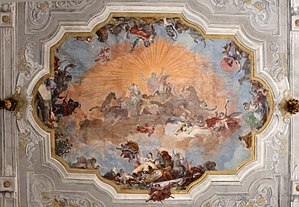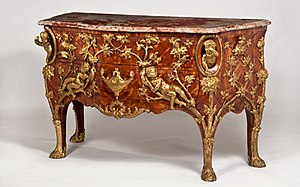
Back Rococo Afrikaans Rokoko ALS روكوكو Arabic روكوكو ARZ Rococó AST Rokoko Azerbaijani Ракако Byelorussian Ракако BE-X-OLD Рококо Bulgarian Rokoko BS
Ballroom ceiling of the Ca Rezzonico in Venice with illusionistic quadratura painting by Giovanni Battista Crosato (1753); Chest of drawers by Charles Cressent (1730); Kaisersaal of Würzburg Residence by Balthasar Neumann (1749 – 1751) | |
| Years active | 1730s to 1760s |
|---|---|
| Location | France, Italy, Central Europe |
Rococo, less commonly Roccoco (/rəˈkoʊkoʊ/ rə-KOH-koh, US also /ˌroʊkəˈkoʊ/ ROH-kə-KOH; French: [ʁɔkɔko] or [ʁokoko] ), also known as Late Baroque, is an exceptionally ornamental and dramatic style of architecture, art and decoration which combines asymmetry, scrolling curves, gilding, white and pastel colours, sculpted moulding, and trompe-l'œil frescoes to create surprise and the illusion of motion and drama. It is often described as the final expression of the Baroque movement.[1]
The Rococo style began in France in the 1730s as a reaction against the more formal and geometric Louis XIV style. It was known as the "style Rocaille", or "Rocaille style".[2] It soon spread to other parts of Europe, particularly northern Italy, Austria, southern Germany, Central Europe and Russia.[3] It also came to influence other arts, particularly sculpture, furniture, silverware, glassware, painting, music, theatre,[4] and literature.[5] Although originally a secular style primarily used for interiors of private residences, the Rococo had a spiritual aspect to it which led to its widespread use in church interiors, particularly in Central Europe, Portugal, and South America.[6]
- ^ Hopkins 2014, p. 92.
- ^ Ducher 1988, p. 136.
- ^ "Rococo writing table". Victoria and Albert Museum. Archived from the original on 21 October 2018. Retrieved 20 October 2018.
- ^ "Rococo style (design)". Encyclopaedia Britannica Online. Archived from the original on 28 August 2012. Retrieved 24 April 2012.
- ^ Baldick 2015.
- ^ Bailey 2014.


